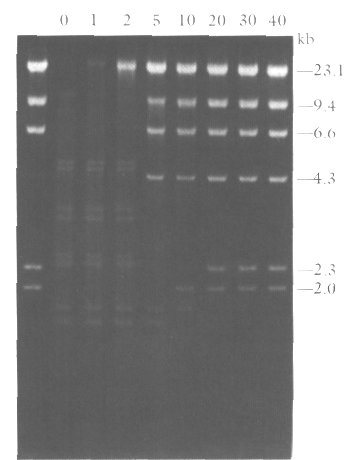TROUBLESHOOTING DNA AGAROSE GEL ELECTROPHORESIS
Shanta Dube
Technical Services
Life Technologies, Inc.
Rockville, Maryland 20849
If you see faint or no bands on the gel:
- There was insufficient quantity or concentration of DNA loaded on the
gel. Increase the amount of DNA, but don't exceed 50 ng/band.
- The DNA was degraded. Avoid nuclease contamination.
- The DNA was electrophoresed off the gel. Electrophorese the gel for
less time, use a lower voltage, or use a higher percent gel.
- Improper W light source was used for visualization of ethidium bromide-stained
DNA. Use a shortwavelength (254 nm) W light for greater sensitivity.
Note: For preparative gels, using a longer wavelength (312 nm)
W light will minimize DNA degradation.
If you see smeared DNA bands:
- The DNA was degraded. Avoid nuclease contamination.
- Too much DNA was loaded on the gel. Decrease the amount of DNA.
- Improper electrophoresis conditions were used. Do not allow voltage
to exceed ~20 V/cm. Maintain a temperature <30°
C during electrophoresis. Check that the electrophoresis buffer
used had sufficient buffer capacity. This is done by checking the pH in
the anode and cathode chambers.
- There was too much salt in the DNA. Use ethanol precipitation to remove
excess salts, prior to electrophoresis.
- The DNA was contaminated with protein. Use phenol extractions to remove
protein prior to electrophoresis.
- Small DNA bands diffused during staining. Add the
ethidium bromide during electrophoresis.
If you see anomalies DNA band migration:
- Improper electrophoresis conditions were used. Do not allow voltage
to exceed ~20 V/cm. Maintain a temperature <30°
C during electrophoresis. Check that the electrophoresis buffer
used had sufficient buffer capacity.
- The DNA was denatured. Do not heat standards [except for l
DNA/Hind III fragments (figure 1)] prior to electrophoresis. Dilute
DNA standards in buffer with 20 mM NaCl.

FIGURE 1. The effect of ionic strength on the heat denaturation
of l DNA/Hind III fragments. 500
ng DNA/Hind III fragments in NaCl concentrations of 0, 1, 2, 5, 10, 20,
30, and 40 mM were electrophoresed after heating at 65° C for 10 min.